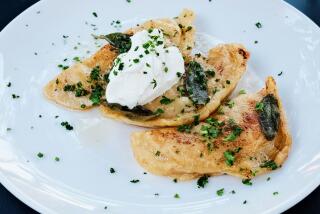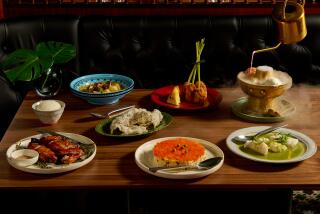In Peak Form
Tibet Nepal House, the first restaurant of its genre to appear in the area, is an appealingly modest space of whitewashed wooden beams, painted devotional scrolls (thangkas) and cheery Nepalese cooks and waiters.
When my wife, who was reared in Nepal, and I dropped in for a meal, what struck us, apart from the correct Tibetan and Nepalese crafts mounted on the soaring walls and the almost obsessively clean decor, was precisely what surprises visitors to Nepal: its vast ethnic diversity. The staff represents a variety of castes, religions and languages. One evening the cook was a Gurung, from the ethnic group that dominates the British army’s famous Gurkha regiment, while waiters were Newars from Nepal’s capital, Katmandu.
Nepalese like to tell you their food is like Indian food, but in fact there are many differences. For instance, many Nepalese dishes are cooked with mustard seed oil, and there are few thick gravies and pungent spice pastes. Tibetan cuisine, meanwhile, is ruled by Tibet’s austere climate and the harsh realities of Chinese rule. These quite different styles of cooking exist here in delicate harmony.
You really ought to start with the Tibetan fried dumplings momocha, which trekkers can eat practically everywhere in Nepal. In the Himalayas, they are generally stuffed with fatty lamb, but here these crunchy, golf ball-sized orbs have either a finely ground chicken filling, or a mixture of transparent noodles, potato and onion. With either kind, you get two light, flavorful chutneys, tomato and cilantro.
From here, there are different paths to nirvana--veg, non-veg, Tibetan or Nepalese.
The best Nepalese meat dish is khasi ko masu, chunks of boneless goat meat stewed with bell peppers, tomatoes, green onions, cilantro, herbs and a hint of ginger. This gamy meat is cooked quite tender, obviously not in haste. Another typical Nepalese dish is khukura ko masu ra saag, stir-fried chicken and spinach laced with spices that taste freshly ground.
The Nepalese vegetable preparations are delicious too and quite distinct from their Indian equivalents. Banda gobi, one of my favorites, is stir-fried cabbage shot through with rye seed, the cabbage browned around the edges, exuding only enough oil to add dimension. Tare ko ram tori is tiny bits of okra, fried crisp and crusted with spice, mixed with chopped tomato.
No Nepalese worth his salt would even consider starting a meal without daalbaat, boiled white rice drowned in watery lentil gravy. Perhaps as a concession to our palates, the lentil portion of the dish is much thicker than it would be in a Nepalese home. Nonetheless, it’s the proper accompaniment for these Nepalese dishes, as is roti, a whole-wheat flat bread much like a homemade flour tortilla.
The Tibetan side of the menu isn’t quite as rigorously authentic as the Nepalese side, for many reasons. Tibetans are Buddhists, but they aren’t vegetarians--not when they’re living at an altitude of 12,000 feet or above. Not many crops will grow there except barley and potatoes, so vegetables play too small a part in their diet for American tastes. On the other hand, yak meat is obviously out of the question in Pasadena.
So you’ll mostly get transparent noodles (ping) mixed with any number of toppings. One of the best ping dishes is thoubu: noodles and tofu spiced up with cilantro, chile, garlic and Sichuan peppercorns (fagara).
Thukpa, the Tibetan noodle soup, is a mere shadow of itself here. In Tibet and Nepal, it’s a thick soup designed to fill the stomach and ward off the cold. This version is basically a watery (though tasty) chicken noodle soup that you might find anywhere in Asia.
For dessert, there’s kheer, a delicate pudding made by boiling down rice and milk, and adding almonds and raisins. There’s also Tibetan butter tea (poecha), served in a pot. But don’t fear, this isn’t the notorious tea flavored with rancid yak butter, which has brought even the most intrepid Western adventurer to heel, but a tame, even bland fresh-butter version.
In the food world, as we know, some things just don’t travel that well.
Tibet Nepal House, 36 E. Holly St., Pasadena. (626) 585-9955. Lunch, 11 a.m.-2:30 p.m., Monday-Saturday; dinner, 5-10 p.m. daily. No alcohol. Street parking. MasterCard and Visa. Dinner for two, $2 to -$37.
What to get: momocha, khasi ko masu, banda gobi, thoubu, kheer.
More to Read
Sign up for The Wild
We’ll help you find the best places to hike, bike and run, as well as the perfect silent spots for meditation and yoga.
You may occasionally receive promotional content from the Los Angeles Times.


![LOS ANGELES, CA - JUNE 17: [Cody Ma and Misha Sesar share a few dishes from their Persian Restaurant Azizam] on Monday, June 17, 2024 in Los Angeles, CA. (Ethan Benavidez / For The Times)](https://ca-times.brightspotcdn.com/dims4/default/7ffc7f6/2147483647/strip/true/crop/5110x3417+306+0/resize/320x214!/quality/75/?url=https%3A%2F%2Fcalifornia-times-brightspot.s3.amazonaws.com%2F79%2Fdc%2F4d29255545f5b9813315901692bc%2F1459972-fo-azizam-review20-eba.JPG)



